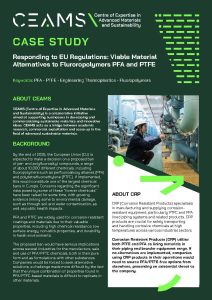CRP collaborated with CEAMS to identify suitable material alternatives to PTFE and PFA ahead of a proposed EU chemical ban that would significant impact the company’s operations. By utilising expertise at Royce, CRP can make streamlined R&D decisions ahead of any potential upcoming regulatory changes.
By the end of 2025, the European Union (EU) is expected to make a decision on a proposed ban of per- and polyfluoroalkyl compounds, a range of about 10,000 different chemicals, including fluoropolymers such as perfluoroalkoxy alkanes (PFA) and polytetrafluoroethylene (PTFE). Changes to the regulatory landscape can have severe consequences on businesses involved in the manufacture, sale and use of these chemicals.
Corrosion Resistant Products (CRP) utilise both PTFE and PFA as lining materials in their piping and broader equipment range. If no alternatives are implemented, companies using CRP products in their operations would need to source PFA/PTFE-free options from elsewhere, presenting an existential threat to the company.
Through the CEAMS programme, CRP collaborated with a Senior Application Scientist from the Henry Royce Institute (Royce) to identify suitable materials that could be used to replace, wholly or in-part, PTFE and PFE usage in CRP’s production line. By accessing Royce’s expertise, CRP are now able to streamline their research and development decisions ahead of the potential EU chemical ban.
—
The Centre of Expertise in Advanced Materials and Sustainability (CEAMS) is funded as part of the Department for Science, Innovation and Technology’s (DSIT) Innovation Accelerator programme. It will build on existing capability anchoring strategic businesses to the area.
Initially funded as a two-year pilot, CEAMS is led by a consortium of expert partners, including: Rochdale Development Agency (RDA), Henry Royce Institute, National Physical Laboratory (NPL), High Value Manufacturing Catapult (HVM Catapult) and its centres: Centre for Process Innovation (CPI), National Composites Centre (NCC), Advanced Manufacturing Research Centre (AMRC) and Manufacturing Technology Centre (MTC).
To learn more about CEAMS, click here




